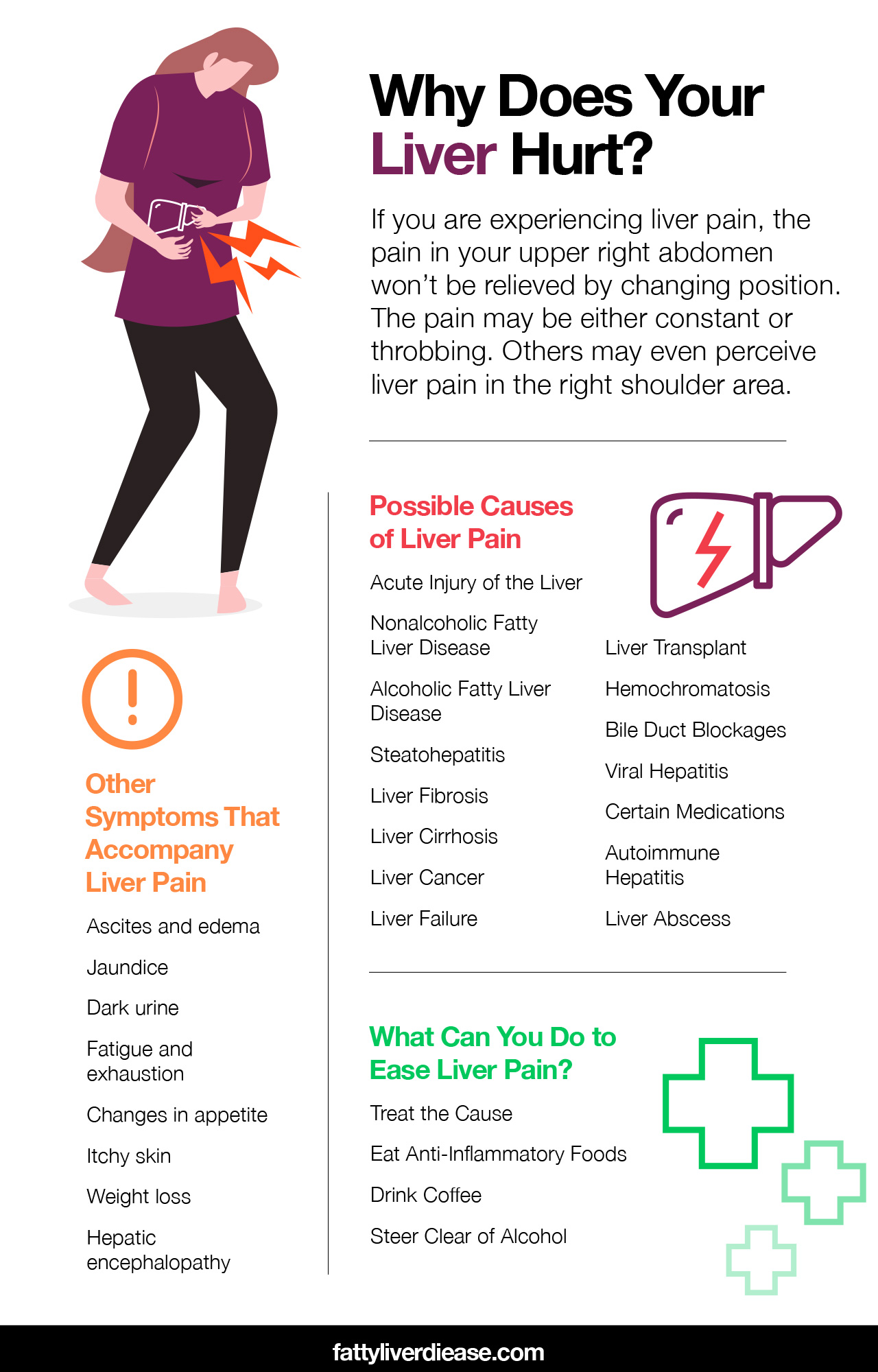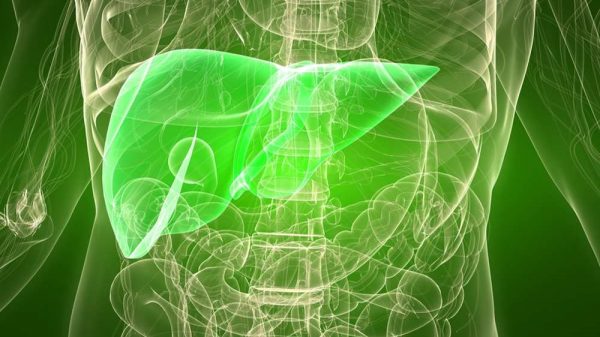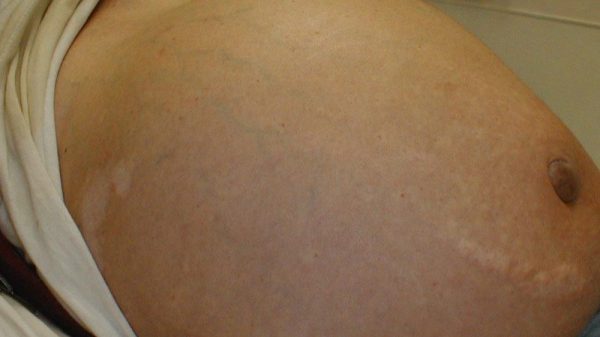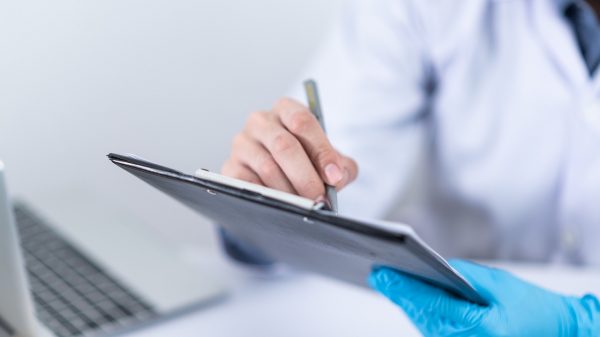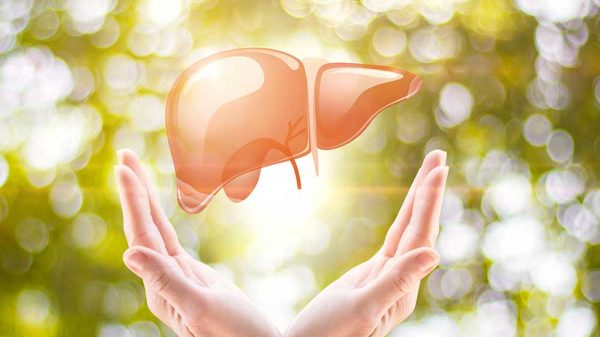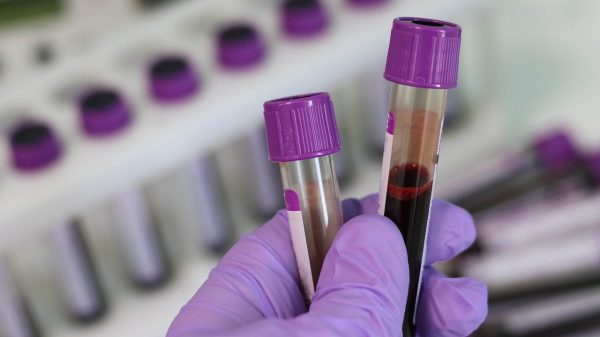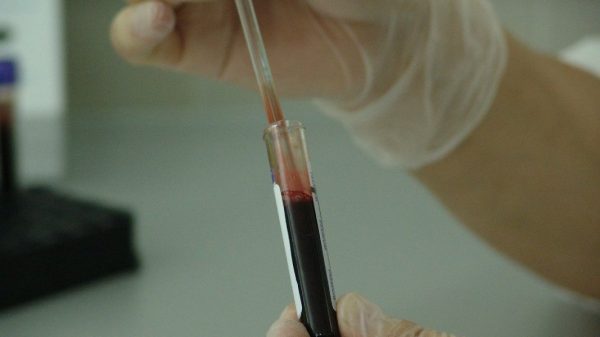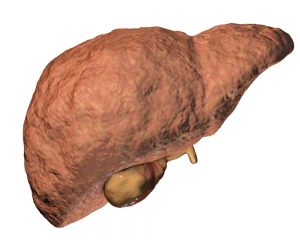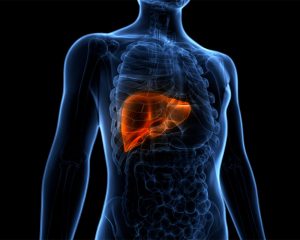Do you have pain in your upper right abdomen? If so, then you may be experiencing liver pain. But why might your liver be hurting? Here we go through possible reasons for liver pain and strive to answer the question: “Why does my liver hurt?”
If you’re experiencing liver pain, then you’ve come to the right place. Read on to find out more about what liver pain indicates about liver health and tips for supporting your liver.
What Does Liver Pain Feel Like?
Before we get into what may be causing liver pain, let’s first discuss what liver pain may feel like. For most individuals with liver pain, the pain affects the upper right quadrant of the abdomen. Some describe it as pain under right rib. Some may experience liver pain as a dull ache, while others experience a sharper pain.
If you are experiencing liver pain, the pain in your upper right abdomen won’t be relieved by changing position. The pain may be either constant or throbbing. Others may even perceive liver pain in the right shoulder area.
Other Symptoms That Accompany Liver Pain
In the early stages of liver disease, you may not notice any symptoms. However, if you have an advanced form of liver disease, you will likely experience several unpleasant symptoms. Here are a few examples of the kind of symptoms that you may experience with liver pain.
- Ascites and edema: In advanced cases of liver disease, the liver is unable to carry out normal metabolic processes. As a result, fluid can build up in different areas of the body. Ascites, in particular, refers to the accumulation of fluid in the abdominal area.
- Jaundice: Jaundice describes yellowing of the skin, whites of eyes, and nails that may occur with liver disease. The yellowing of the skin arises from excess bilirubin in the body.
- Dark urine: Excess bilirubin in the bloodstream also impacts the color of urine for individuals with liver disease. When bilirubin is not processed by the liver, it enters the urine through the kidneys, giving the urine a much darker appearance than usual.
- Fatigue and exhaustion: Fatigue is one of the early symptoms you may notice with liver disease. When the liver is damaged, it cannot successfully carry out biological processes that the body needs to produce energy. As a result, you may feel more tired and sluggish than usual.
- Changes in appetite: You may lose your appetite when you have liver disease. In addition to the loss of appetite, you may also experience nausea and vomiting.
- Itchy skin: Itchy skin may accompany liver conditions due to the buildup of bile salts beneath the skin.
- Weight loss: You may notice that you unintentionally lose weight when you have liver disease. Muscle wasting also occurs with advanced liver disease.
- Hepatic encephalopathy: Hepatic encephalopathy occurs in the later stages of liver disease when the liver cannot detoxify harmful compounds. This causes an accumulation of certain metabolic byproducts, like ammonia, in the bloodstream. These components travel to the brain and interfere with normal neurological functioning. Symptoms may include confusion, anxiety, seizures, and involuntary movements.
Possible Causes of Liver Pain
Here we go through the possible causes of liver pain.
1. Acute Injury of the Liver
If your liver has been physically damaged by impact, the tissue will react just like any other tissue. The liver will become inflamed and bruised as it heals. Physical impact and injury can cause pain in the liver. If you have sustained an injury in the abdomen, it’s imperative to seek medical attention immediately. Internal bleeding and other injuries must be promptly treated to avoid complications.
2. Nonalcoholic Fatty Liver Disease
Nonalcoholic fatty liver disease – also referred to as NAFLD – results from a combination of diet and lifestyle factors, as well as genetic predisposition. Fatty liver disease is defined by the buildup of fat within liver cells and is one of the more common causes of liver inflammation. This form of fatty liver disease does not arise from excessive drinking. Instead, consumption of excess sugar and saturated fat are the primary culprits. Nonalcoholic fatty liver disease is also associated with other risk factors, including metabolic conditions such as obesity, type 2 diabetes, insulin resistance, and high cholesterol.
3. Alcoholic Fatty Liver Disease
In contrast to nonalcoholic fatty liver disease, alcoholic fatty liver disease is caused by chronic and heavy alcohol consumption. The liver is responsible for detoxifying alcohol, and when excess alcohol is consumed, the liver can become overwhelmed. This leads to inflammation and oxidative stress, which irritates liver tissue and causes the accumulation of fat within liver cells.
4. Steatohepatitis
Steatohepatitis is a progressed form of either alcoholic or nonalcoholic fatty liver disease. When fat accumulates in the liver over a significant period of time, liver tissue becomes irritated, and inflammation ensues. At this stage, fatty liver disease advances to steatohepatitis, and you are more likely to exhibit symptoms like liver pain and fatigue.
If fatty liver disease progresses to steatohepatitis, you are more likely to develop even more advanced forms of fatty liver disease like liver fibrosis and liver cirrhosis.
5. Liver Fibrosis
Liver fibrosis is the next stage in the progression of fatty liver disease. Liver fibrosis describes the production of fibrotic tissue in the extracellular matrix outside of liver cells. Fibrosis also contributes to inflammation through the activation of inflammatory agents like cytokines.
Continued liver fibrosis can cause scar tissue to accumulate, impeding liver processes. More severe symptoms may arise, including liver pain, jaundice, easy bruising, and fatigue. Eventually, continued fibrosis leads to liver cirrhosis.
6. Liver Cirrhosis
Liver cirrhosis is a form of advanced liver damage that develops from untreated fatty liver disease. A cirrhotic liver is heavily scarred and contains hardened scar tissue areas that get in the way of normal functioning. When hard scar tissues build up in the liver, this means that the liver is damaged, which can result in significant liver pain.
7. Liver Cancer
Liver cancer – also known as hepatocellular carcinoma – is characterized by the accumulation of malignant cells in the liver. An individual is at a higher risk of developing liver cancer after years of liver inflammation and damage. Damage inflicted upon the liver breaks the DNA that’s present in all liver cells. Though the body can usually induce apoptosis (cell death) in these cells, chronic damage can impact these processes and result in more cells with dysfunctional DNA. When these cells proliferate, they form cancer. The formation of tumors in the liver can be extremely painful and cause pain in the abdomen.
8. Liver Failure
Liver failure describes extensive damage in the liver that mostly or entirely impedes liver function. Liver failure may result from severe liver cirrhosis or liver cancer. Severe symptoms accompany liver failure, including fatigue, weight loss, jaundice, edema, ascites, and mental symptoms resulting from hepatic encephalopathy. The only effective form of treatment for liver failure is to undergo liver transplantation.
9. Liver Transplant
Liver transplantation is the most successful form of treatment for liver failure. If you’ve recently undergone a liver transplant surgery, it is natural to feel pain in the liver area. This is because the liver must heal from the procedure, which can precipitate pain.
If liver transplantation is not successful, the body may reject the transplanted liver. In some cases, the body may recognize the new liver as an invader that is not supposed to be in the body. As a result, the immune system will activate and attack the transplanted liver tissue. Rejection of the new liver often requires prompt medical attention. Immunosuppressant drugs may be administered to stop immune system activity. Or, another liver may be transplanted.
10. Hemochromatosis
Hemochromatosis is a genetic disorder characterized by the accumulation of iron throughout the body. Individuals with hemochromatosis have a genetic tendency to absorb excess iron levels instead of the proper amount that the body needs. When iron is not processed correctly, it accumulates in different areas of the body, such as the joints, pancreas, heart, and liver.
11. Bile Duct Blockages
The bile duct is responsible for carrying bile fluids from the liver to the gallbladder, and ultimately to the small intestine to be utilized in the breakdown of fats. Biliary ducts may become blocked due to gallstones, which accumulate in the gallbladder and may cut off the bile flow between the liver and gallbladder. As a result, fluid and bacteria may accumulate in the liver, causing significant inflammation, infection, and pain.
12. Viral Hepatitis
Hepatitis A, hepatitis B, and hepatitis C are forms of viral hepatitis that cause significant liver inflammation. Hepatitis C is one of the more common viral infections affecting the liver among individuals in the United States, with other forms of hepatitis being less common.
Hepatitis C is transmitted through sexual contact or with contaminated blood. Infection with hepatitis C may not show any symptoms for a long time. Over time, infection with the hepatitis C virus leads to liver inflammation and scarring, which can precipitate symptoms.
13. Certain Medications
Certain medications, both prescription and over-the-counter, may result in liver damage. One of the most well-known medications that can cause liver damage is acetaminophen, also known as Tylenol. Tylenol is typically taken for minor pain or fever, and when taken as directed, is safe for use among the general population. However, if you are a heavy drinker or suffer from metabolic syndrome, you may be at a greater risk for sustaining a liver injury from acetaminophen.
Statins are another class of medications that are associated with liver damage. Statins are beneficial for treating high cholesterol and managing metabolic syndrome. Though statins are generally safe, certain individuals may rarely develop elevated liver enzymes.
Always make sure you check in with your health care provider and undergo necessary testing and evaluation before stopping any medications. If taking statins causes a little bit of liver inflammation, you may need to be monitored. Stopping statin medications may pose a larger risk to your health than elevated liver enzymes. It’s always critical to make sure you discuss medications and treatment plans with your physician.
If your case of liver pain or liver inflammation has been determined to be linked to a medication you’re taking, your physician will also be able to recommend an alternative drug that can treat your conditions without causing liver irritation.
14. Autoimmune Hepatitis
Autoimmune hepatitis is a condition that causes inflammation of the liver. Immune system dysfunction is the cause of autoimmune hepatitis. Normally, the immune system is programmed to attack invading viruses and bacteria, as well as deformed cells. However, in the case of an autoimmune condition, the immune system recognizes healthy tissue as a threat and attacks the healthy tissue. The immune systems of individuals with autoimmune hepatitis attack liver tissues, causing inflammation and damage.
15. Liver Abscess
A liver abscess is a pocket of pus present in the liver that can cause a considerable amount of pain. In many cases, liver abscesses result from bacterial infections. If you have a liver abscess, you may need to take antibiotics to get rid of the infection. You may also need to undergo a procedure to drain the abscess of pus.
Diagnosis of Liver Issues
If you think you may be experiencing liver issues, it’s critical to see your doctor as soon as possible. A physician will be able to evaluate your symptoms, perform tests, make an accurate diagnosis of your condition, refer you to specialists, and devise a specialized treatment plan.
How can a physician identify whether you have a liver condition? There is a multitude of tests that a doctor can use to evaluate the health of your liver:
- Evaluating symptoms: If you are reporting liver pain and other indicators of liver disease like unintended weight loss, nausea, and jaundice, these symptoms may provide information for your doctor about what tests to administer.
- Palpation: Palpation is part of a physical examination in which the physician can feel your liver and potentially detect enlargement or other abnormal masses.
- Blood tests: Blood tests can reveal information about your liver health. For example, elevated levels of alanine transaminase (ALT) and aspartate transaminase (AST) may indicate damage and inflammation within liver cells.
- Imaging: Imaging tests like computed tomography (CT) scans, magnetic resonance imaging (MRI), and ultrasounds can provide valuable information about the health of your liver. Imaging tests can reveal enlargement of the liver, the presence of fatty tissue, the texture of liver tissue, and other abnormalities.
- Liver biopsy: A liver biopsy is a very accurate way of diagnosing liver conditions. A liver biopsy requires the evaluation of a very small tissue sample of liver tissue. The sample is then evaluated in a laboratory for abnormalities, such as the presence of fat and scar tissue.
What Can You Do to Ease Liver Pain?
Managing your liver condition and quelling associated inflammation and damage is the most effective way to reduce liver pain.
1. Treat the Cause
If you are experiencing liver pain, it’s important to pinpoint the underlying cause of your pain. A physician can confirm whether the pain you are experiencing is related to the liver, and the reasons for liver pain. Then, you can start medications or a new dietary plan to help prevent the progression of fatty liver disease.
For example, you will need to take antiviral medications to treat hepatitis C. To manage liver pain in connection to blocked bile ducts, you may need a cholecystectomy or other procedure to remove gallstones.
2. Eat Anti-Inflammatory Foods
Making diet and lifestyle changes are critical for preserving liver health. The liver is very responsive to healthy diet and lifestyle adjustments. Eating anti-inflammatory foods helps your liver repair from inflammation and oxidative stress.
Keep in mind that in the early stages of fatty liver disease, the condition may be completely reversed with diet and lifestyle changes. The liver can regenerate and repair in later stages of liver disease as well, although it becomes less likely with increasingly advanced liver disease.
Here are a few guidelines for supporting a liver-friendly diet and lifestyle:
- Avoid refined grains and added sugar. Eating sugar and refined grains in excess interferes with healthy metabolic functioning and worsens liver inflammation. Keep refined grain and sugar consumption to a minimum by avoiding white bread, white rice, white pasta, pastries, sugary breakfast cereals, and soda. Instead, consume whole-grain products like whole-grain bread and pasta, quinoa, and millet.
- Eat plenty of protein. Eating high-quality protein that offers optimal ratios of essential amino acids helps your body repair and fight against symptoms of fatty liver disease. Amino acids are the raw materials that the body needs to build muscle tissue, hormones, neurotransmitters, and enzymes. Certain essential amino acids may even be connected to reducing fat accumulation in the liver. Fish high in omega-3 fatty acids, lean meats like chicken breast, and low-fat dairy are excellent sources of protein. Tofu, tempeh, beans, nuts, and seeds are great sources of vegetable-based protein.
- Keep fruit and veggie intake high. Fruits and vegetables are chock-full of micronutrients like vitamins, polyphenols, and carotenoids that exhibit antioxidant activity and help soothe inflammation in liver tissue. Incorporate foods like kale, broccoli, cauliflower, spinach, blueberries, and strawberries into your diet.
- Strive for a healthy weight. Being overweight worsens liver inflammation and fat accumulation in liver tissue. Losing weight, when necessary, can help clear fat from your liver while also improving inflammation. Eating a healthy diet, managing stress, consuming an appropriate number of calories, and increasing your physical activity are healthy strategies for achieving a healthy weight.
- Eat lots of fiber. Fiber is crucial for supporting a healthy digestive system. Maintaining a healthy microbiome that contains a balance of good bacteria can support the health of other organ systems, including the liver. Eating a fiber-rich diet supports the growth of good bacteria in the gut. These good bacteria produce anti-inflammatory compounds as metabolic byproducts, which then enter the bloodstream and travel to other areas of the body. These compounds help lower inflammation in the liver. You can get plenty of fiber in your diet by eating lots of fruits, vegetables, beans, and whole grains.
- Replace bad fats with good fats. First, it’s important to cut unhealthy fats out of your diet. Saturated fats found in foods like bacon, steak, cheese, cream, and whole milk make metabolic function and liver function worse. Replace bad fats in your diet with healthy polyunsaturated fats found in foods like pecans, walnuts, pumpkin seeds, chia seeds, and flaxseeds. Fatty fish like salmon and mackerel also offer liver-friendly omega-3 fatty acids in the form of eicosapentaenoic acid (EPA) and docosahexaenoic acid (DHA).
3. Drink Coffee
Drinking coffee has been shown to be therapeutic for the liver by protecting against the accumulation of fat and inflammation. Aim to drink 1-2 cups of regular brewed coffee on a daily basis. However, it’s easy to turn a coffee beverage into an unhealthy liver irritant by adding lots of sugar, whole milk, and cream. Instead, stick to low-calorie, low-fat, and low-sugar additions like almond milk or oat milk. Soy milk and skim milk are also excellent additions to coffee because they contain high-quality protein.
4. Steer Clear of Alcohol
Removing alcohol from your daily routine is important for supporting liver health and helping to reduce inflammation and subsequent pain. Alcohol abuse is a major contributor to liver disease. If you suffer from alcohol-related liver disease, you may have asked yourself: “Why does my liver hurt after drinking?”
If you are physically dependent on alcohol, you must slowly and carefully wean yourself off alcohol. It’s best to seek medical advice and guidance for breaking your physical dependence on alcohol. Detoxing from alcohol may cause severe symptoms that jeopardize your health, such as shaking, anxiety, rapid heart rate, seizures, and hallucinations.
Things to Keep in Mind: Pain May Not Be Connected to the Liver
How can you be sure that the abdominal pain in right side under ribs can be attributed to the liver? The truth is, there’s no surefire way to be sure that your pain is originating from your liver. It’s important to keep in mind that the pain you are feeling may not be connected to the liver. Pain in the abdomen can result from a variety of causes. In order to determine the cause of your pain, it’s always important to be evaluated by a doctor.
Conclusion: Why Does My Liver Hurt?
If you have pain in the upper right abdomen, you may be experiencing liver pain. Liver pain may signify liver problems, which are important to address as soon as possible. Accompanying symptoms may include fatigue, weight loss, ascites, and yellowing of the skin. Intervening in earlier stages of liver disease yields better outcomes. If you are experiencing liver pain and symptoms of liver disease, it’s always critical to seek medical attention and receive an exact diagnosis and treatment recommendations. Diet and lifestyle changes can also help lower liver inflammation, halt the progression of disease, and improve liver pain.
